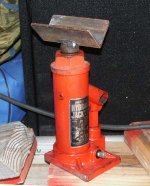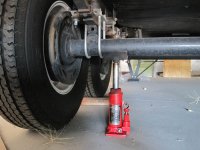Although jacking by the frame may be the recommend way it is not always practical. Nor the safest in my opinion.
Either way, I would leave it hooked up to the truck if possible. Parking brake applied and trailer chocked.
Jacking by the frame puts a tremendous amount of stress in a concentrated area. And you need to do a lot of lifting to overcome the spring travel.
The only way you are going to do that is with blocking. That by itself leads to instability. I seriously doubt more then just a few people keep enough of the proper material to safely form "cribbing" to get the jack near the frame.
Think of the stress if you are not using two jacks, lifting equally, in front of and behind the axles. With a jack on the frame you are trying to lift half your trailer weight on 2 square inches of frame. 2 axle trailers have 4 mounting points spread across maybe 6 feet supporting half the weight.
If I needed to manually jack - if the axle is above the spring then jack under the spring pad. If the axle is mounted below the spring, have made a jack cradle for your bottle jack (piece of angle welded to the screw forming a "V").
Jacking the axle means only having to jack just far enough to get the tire off, and inch or 2. And you can minimize that by driving the good tire up on a board or two.
Don't scrimp on your choice of jacks. I bough ta low profile 20 ton bottle jack to fit under the MOR/ryde IS parts. 20 ton sounds like overkill, but it was only $20 more then the smaller versions, the base has probably double the square inches of pad over the typical bottle jack and it is very easy to lift.
When your laying on the side of the road the 20 ton jack is 3 times easier to pump then the typical 6 ton.
But, I must digress, it is far easier to push the button and lift the offending side off the ground.
LevelUp and power cord reel, 2 best things I did to our trailer.
To the OP, your concern is genuine, improper placement of the jack will bend your axles, and they can't be bent back.


